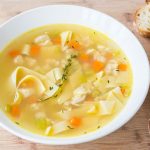 A liquid food made by boiling meat, vegetables, fish, etc., in water with various seasoning agents.
A liquid food made by boiling meat, vegetables, fish, etc., in water with various seasoning agents.
Queen Elizabeth I could never have eaten soup: the word did not enter English until the mid seventeenth century, fifty years after her death. She did, however, eat souplike foods with names such as pottage and broth, and no doubt she also dined occasionally on something called a sop, a piece of bread soaked in broth. In fact, the word soup derives from the same source as sop, and even originally meant the same thing—a soaked piece of bread. The common source that soup and sop developed from, although by different routes, was the Germanic word sup, meaning juice or sap. This Germanic word evolved more or less directly into the Old English sop, the soaked-bread dish whose name was first recorded in the twelfth century; although sops are no longer commonly eaten, the word itself persists in phrases like sopping wet and in words like milksop, a bread-slice soaked in milk whose name became synonymous in the thirteenth century with effeminate men. Taking a different and less direct path, the Germanic sup also entered Late Latin as suppa, which evolved into the French soupe, originally denoting the soaked bread-slice itself, but eventually coming to mean the broth in which the bread was soaked. English borrowed this soupe from French and bestowed it upon a liquid food thicker than a broth but thinner than a pottage. Still other English words also developed from the Germanic sup, including sob—a tearful and therefore watery cry of anguish—and sip—the action of drinking small amounts at a time. Perhaps the most familiar descendent, however, is supper, from the Germanic sup, French developed super, a word meaning to eat the evening meal (this super is no relation to the super in superman); English borrowed the French super at the end of the thirteenth century, using it as the name of the day’s last meal and adding another p to the word in the process.
Soup, commonly gracing the table as the introductory course of a luncheon or dinner, or even taking center stage as the main dish of a light lunch or supper, serves a dual purpose. Not only does it awaken and stimulate the appetite for the forthcoming courses, but it also contributes substantial nutritional value to the meal.
